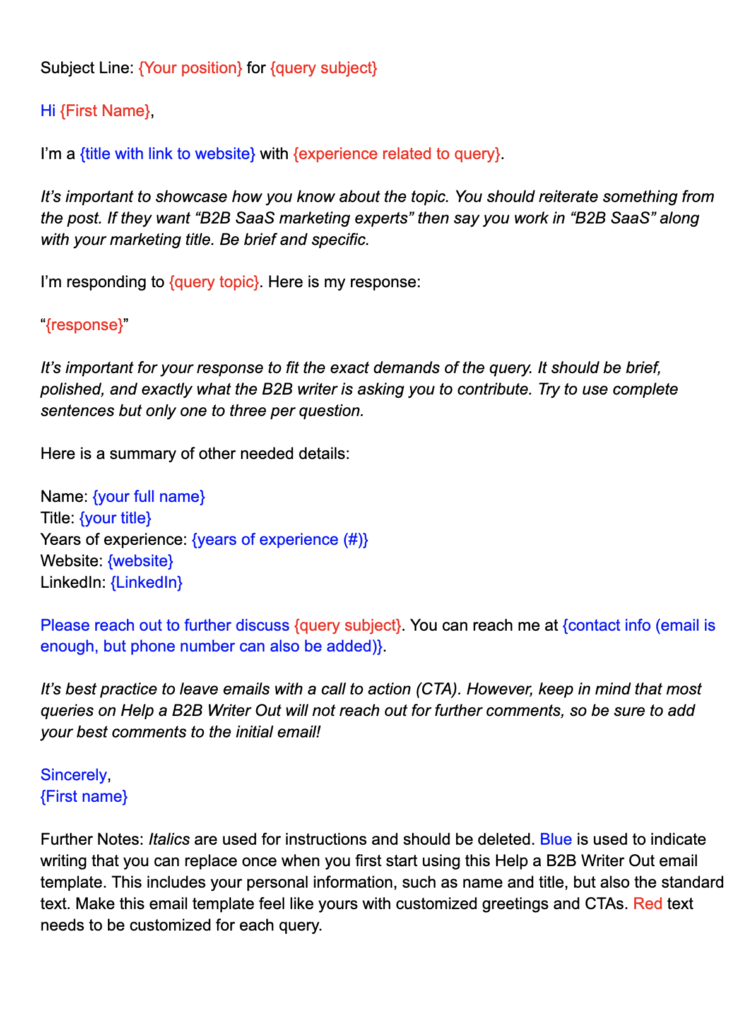How are you building backlinks in 2022? One of the current trends in backlink outreach is directly contacting journalists. Help a Reporter Out (HARO) is one popular route to get your website in the hands of reporters, but it is not the only one. In fact, HARO has become so popular that it is difficult to get reporters to choose your quotes for their pieces. That’s one of the reasons why I prefer Help a B2B Writer (HaB2BW).
Help a B2B Writer is just like HARO but for content writers instead of news reporters. This gives you an edge when it comes to pitching your ideas. However, to maximize your chances the writer chooses to include your quote in their content, you need a great email template.
What is a backlink?
Backlinks are essentially other websites linking to your website and thus giving their seal of approval to your website. Backlinks are extremely important. I discuss backlinks a bit more in my article on how to develop a blog content strategy.
Why are backlinks important?
Backlinks are one of the main goals of SEO. Google uses the backlink portfolio of a website to help determine its quality. This is true for both your website’s homepage, which should be the primary target for backlinks, and those of individual blog posts, which you should also try to support with backlinks.
There are several different components that Google weighs when determining the quality of your backlink profile. While Google keeps their precise formula a secret, which is why Ahrefs and SEMrush will give you different scores, we do have a rough idea of how a backlink profile is ranked by Google.
Quality of backlinks
Not all backlinks are equal. My website gets a lot of spammy backlinks from random websites that just list every website on the planet or all the websites registered with Alexa (which is disappearing soon, unfortunately).
My basic writing packages include a provision to have an “about the author” blurb that links back to my website as well as my LinkedIn profile. This helps build the power of my website so I can find new clients.
I’ve been fortunate enough to have received some very strong backlinks this way, including from Baremetrics, which Ahrefs lists as having a URL Rating (UR) of 78. The UR is a 100-point scale that estimates the strength of a backlink profile. It basically tells you how much the backlinks from a website are worth to the receiving website of that backlink.
A backlink from a website with a UR of 78 is worth much more than 78 backlinks from 78 websites with a UR of 1. How much more is really hard to know (Google keeps this a secret), but building a few very high-quality backlinks is probably going to help your website a lot more than building many low-quality backlinks.
Volume of backlinks
While high-quality backlinks are more important, the volume of backlinks is still an important factor in determining the strength of your backlink profile. So long as your backlinks aren’t toxic (SEO penalized due to the website being considered spammy or scammy), even the low-quality backlinks will help you (a little).
Don’t worry if you do attract some toxic backlinks though, as Google recognizes and ignores them automatically. You no longer need to go through the entire backlink disavow process.
Backlink relevance
This is basically a determination of whether your backlinks are relevant to your website. I’m a B2B SaaS content writer. Backlinks in my “about the author” blurbs are highly relevant and therefore highly help my ranking.
If you try to build backlinks on any website that will let you, then not all of the backlinks will be relevant. Google will end up ignoring these backlinks—or worse penalize you for them—and that’s a lot of wasted effort.
Link types: dofollow vs. nofollow vs. ugc
These are the types of links that you can insert in your HTML code. Google used to completely ignore some types, but now they look at them all and treat them differently.
- dofollow: You are telling Google to follow this link and treat the other website as an extension of your own knowledge. These are the highest value links.
- nofollow: You are telling Google not to follow this link. They still provide some value, but not as much as dofollow links.
- User Generated Content (ugc): This indicates the link was added by a user and not the website’s owner (for example, in a comment on a blog). These are mostly considered worthless now.
There is also the possibility to list a link as “sponsored” as well. You should do this when you have been paid to include the link or the link goes to a website which might pay you, for example as an affiliate marketer.
What are the ways you can do backlink outreach?
There are many ways to attract backlinks. They range from completely passive to highly active. They can also be grouped into black hat or white hat methods.
Let’s take a look at these separately.
White hat vs. black hat
Here, white hat and black hat refer to how Google views the methods:
- White hat: White hat methods are those approved by Google as not “cheating”. All the methods I list below are white hat methods (or at least considered white hat at the time of writing).
- Black hat: Black hat methods are considered cheating. Google does not like this, and it is possible that a future update of their algorithm will ruin any black hat effort you’ve made. Like most reputable B2B SaaS marketers, I advise against black hat methods. They aren’t worth the price and they aren’t ethical. Black hat methods can be summarized as “buying backlinks”, as most black hat methods require payments and Google wants companies to generate their backlinks organically on the merits of the content.
Backlink outreach methods
Here is a list of some common backlink outreach methods, in order from passive to active. The more active methods are usually going to be more effective, but the labor costs make them less feasible if you are a small company with a small budget.
- Wait: In this system, you write great content and wait for the world to see it. Hopefully searchers are so impressed by the content that they link back to your articles.
- Amplify: Once you’ve written a blog post, you share it on social media and hope people notice and add the links to their articles.
- Message: This method has many names and different specifics, but the basic idea is that you email people with similar content and ask them to insert a backlink to your article because it is so good.
- Trade: This is similar to the messaging method, but instead of asking for a backlink you offer to trade backlinks. You put a link on your site to the targeted site in exchange for the reciprocating backlink. (Note that this might be considered black hat at some point in the future.)
- PR: Public relations (PR) is looking to get recognition in the media. This is what I am discussing today and includes replying to requests on Help a B2B Writer.
- Guest Post: This is a very time-consuming method, but if you have the budget, it is a great method. Instead of writing an article for your own blog, you write an article for another website’s blog and include links back to your website as well as one or two articles on your blog. The requirements for guest posts can be high, but it is probably the most likely to succeed when aiming for very high UR websites.
Help a B2B Writer vs. HARO vs. #journorequest
Where are you running your PR campaign? Do you use Twitter regularly? If you do, you might have seen the #journorequest hashtag. This is a great place to find journalists looking for sources on Twitter.
However, if you don’t use Twitter, then HARO and Help a B2B Writer are great ways to find PR opportunities. They both operate the same way. You sign up as a source on the website, and then requests come to your email inbox. In fact, they are so similar that you can definitely use my Help a B2B Writer email template for HARO as well.
The major difference between these two services is the scale. HARO is way bigger. You’ll see more requests, and often requests for much higher UR websites, on HARO. The downside of this is the competition.
While getting your website mentioned in the New York Times or Washington Post is going to be hugely valuable, you could pitch journalists at these newspapers a thousand times and never be mentioned. That’s why I recommend that you use Help a B2B Writer (HaB2BW) as your primary PR email service.
However, it doesn’t need to be a HARO vs. HaB2BW decision, you can use both. In fact, you should use both!
Help a B2B Writer email template
This is the Help a B2B Writer email template I use to attract backlinks. Note that you can copy the text below, or click here for the Google Docs version and then make a copy on your own drive.

HaB2BW email template
Here’s the text version:
Subject Line: {Your position} for {query subject}
Hi {First Name},
I’m a {title with link to website} with {experience related to query}.
It’s important to showcase how you know about the topic. You should reiterate something from the post. If they want “B2B SaaS marketing experts” then say you work in “B2B SaaS” along with your marketing title. Be brief and specific.
I’m responding to {query topic}. Here is my response:
“{response}”
It’s important for your response to fit the exact demands of the query. It should be brief, polished, and exactly what the B2B writer is asking you to contribute. Try to use complete sentences but only one to three per question.
Here is a summary of other needed details:
Name: {your full name}
Title: {your title}
Years of experience: {years of experience (#)}
Website: {website}
LinkedIn: {LinkedIn}
Please reach out to further discuss {query subject}. You can reach me at {contact info (email is enough, but phone number can also be added)}.
It’s best practice to leave emails with a call to action (CTA). However, keep in mind that most queries on Help a B2B Writer will not reach out for further comments, so be sure to add your best comments to the initial email!
Sincerely,
{First name}
A PR marketing strategy done for you
If you don’t have the capacity for PR outreach in-house, feel free to drop me a line. A couple hours of consultation up front gives me the information I need to send you the specific opportunities on Help a Reporter Out or Help a B2B Writer along with pre-written emails.
You can edit them to match your skills and abilities and send them along.

